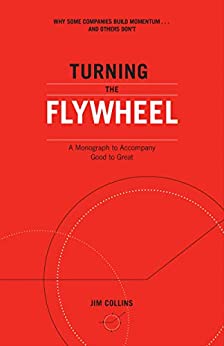More on this book
Community
Kindle Notes & Highlights
by
Jim Collins
Read between
March 5 - August 6, 2019
Once you fully grasp how to create flywheel momentum in your particular circumstance (which is the topic of this monograph) and apply that understanding with creativity and discipline, you get the power of strategic compounding. Each turn builds upon previous work as you make a series of good decisions, supremely well executed, that compound one upon another. This is how you build greatness.
It went something like this: Lower prices led to more customer visits. More customers increased the volume of sales and attracted more commission-paying third-party sellers to the site.
the underlying flywheel architecture remained largely intact, creating a customer-value compounding machine that many of the largest companies in the
world came to fear.
Never underestimate the power of a great flywheel, especially when it builds compounding momentum over a very long time.
Notice how each component in the Vanguard flywheel isn’t merely a “next action step on a list” but almost an inevitable consequence of the step that came before.
The Vanguard case exemplifies a key aspect of how the best flywheels work. If you nail one component, you’re propelled into the next component, and the next, and the next, and the next—almost like a chain reaction. In thinking about your own flywheel, it’s absolutely vital that it not be conceived as merely a list of static objectives that you’ve simply drawn as a circle. It must capture the sequence that ignites and accelerates momentum.
the greatest danger in business and life lies not in outright failure but in achieving success without understanding why you were successful in the first place.
When you deeply understand the underlying causal factors that give your flywheel its momentum, you can avoid Burgelman’s trap.
One of the biggest, and most common, strategic mistakes lies in failing to aggressively and persistently make the most of victories.
But to do so requires understanding the underlying architecture of the flywheel as distinct from a single line of business or arena of activity.
Design new chips that customers crave; price high before competition catches up; drive down unit costs as volume increases (due to economies of scale); harvest high profits even as competition drives down prices; and reinvest those profits into R&D to design the next generation of chips.
But before you decide to toss out your flywheel, first make sure you understand its underlying architecture. Don’t abandon a great flywheel when it would be a superior strategy to sustain, renew, and extend.
we’ve developed a basic process, refined during Socratic-dialogue sessions with a wide range of organizations. Here are the essential steps: Create a list of significant replicable successes your enterprise has achieved. This should include new initiatives and offerings that have far exceeded expectations. Compile a list of failures and disappointments. This should include new initiatives and offerings by your enterprise that have failed outright or fell far below expectations. Compare the successes to the disappointments and ask, “What do these successes and disappointments tell us about the
...more
(keeping it to four to six), sketch the flywheel. Where does the flywheel start—what’s the top of the loop? What follows next? And next after that? You should be able to explain why each component follows from the prior component. Outline the path back to the top of the loop. You should be able to explain how this loop cycles back upon itself to accelerate momentum. If you have more than six components, you’re making it too complicated; consolidate and simplify to capture the essence of the flywheel. Test the flywheel against your list of successes and disappointments. Does your empirical
...more
biggest replicable successes as outcomes arising directly from the flywheel, and your biggest disappointments as failures to execute or adhere to the flywheel. Test the flywheel against the three circles of your Hedgehog Concept. A Hedgehog Concept is a simple, crystalline concept that flows from deeply understanding the intersection of the following three circles: (1) what you’re deeply passionate about, (2) what you can be the best in the world at, and (3) what drives your economic or resource engine. Does the flywheel fit with what you’re deeply passionate about—especiall...
This highlight has been truncated due to consecutive passage length restrictions.
flywheel help fuel your economic or resource engine? (In the appendix to this monograph, I’ve created a short summary of the framework of concepts that have come from our research—concepts such as the Hedgehog Concept—along with a brief definition of each concept. This appendix also shows where the flywheel fits in the overall conceptual map for the journey from good to ...
This highlight has been truncated due to consecutive passage length restrictions.
the big winners in corporate history consistently surpassed a threshold level of innovation required to compete in their industries. But what truly set the big winners apart was their ability to turn initial success into a sustained flywheel, even if they started out behind the pioneers.
Teaching is a relationship, not a transaction, and Gustafson believed that relationships could be built only on a foundation of collaboration and mutual respect.
The flywheel, when properly conceived and executed, creates both continuity and change. On the one hand, you need to stay with a flywheel long enough to get its full compounding effect. On the other hand, to keep the flywheel spinning, you need to continually renew, and improve each and every component.


